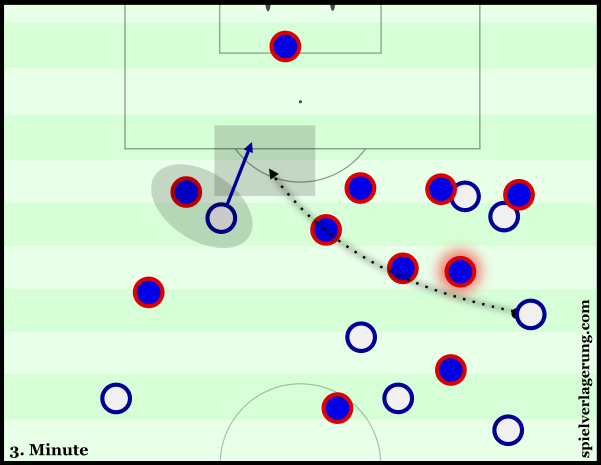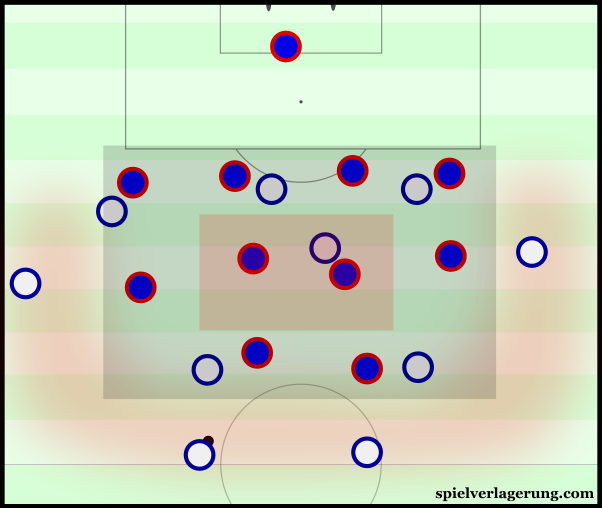Hodgson’s England crash out of EUROs against compact Iceland
England crashed out of the EUROs in typically-English fashion as they lost 1-2 to an underestimated Icelandic team. Despite starting the game well, with a goal and some decent play in possession, the team were held back by some inappropriate mid-game changes from Hodgson.
Icelandic defence
Despite being given minimal praise from the numerous experts on television, Iceland’s defensive performance was impressive as they held England to less than 1 expected goal over the duration of the 90 minutes. Although some deficiencies were evident, they held fairly good compactness in a zonally-marking defensive block which served to blunt what was a fairly strong English attack in the group stages.
Whilst many teams in the tournament have defended with the opposition player as by and large the main reference point, Iceland were less rigid in their approach and their team-mates’ positioning was also used situationally. Instead of being dragged out of position, the individual midfielders knew when to hold their positions and when to follow their men, leading to a more stable defence. Although they were man-oriented to some extent, they were following their man less rigidly and were flexible enough to switch positions when necessary to allow a more balanced defensive shape.
When England had the ball within their defensive line, the two forwards would screen the space in front of their midfield and block passes into Dier. Böðvarsson would situationally drop directly onto the Spurs defender and create a 4-4-1-1 structure when necessary but more often they used cover shadows. This tactic was fairly effective in slowing down England’s build-up, which instead was directed into wide areas which could be more-easily defended by Lagerbäck’s team. Iceland maintained fairly strong levels of compactness in the centre which allowed them to exercise control without the ball as they isolated England’s poorly-positioned attackers.
It wasn’t surprising to see Lagerbäck’s team quickly drop back into a low-block which England has struggled to convert against in recent outings. They packed out their own box and easily outnumbered England’s attackers who were thus unable to make any impact on the game.
England unable to fully exploit weaknesses
They did have some defensive weaknesses and although this wasn’t exploited to much extent by England, were enough to be cause for concern. Perhaps biggest was the situational passivity in their midfield pressing. Once England had beaten the defensive coverage of the front two, Iceland had some issues in moving out to press and re-create access as they were slightly too passive at times which gave England the time to pick out holes in the midfield. This was an important factor in the play which led to England’s go-ahead penalty in the opening stages of the game. Daniel Sturridge picked the ball up in a wide-right position and was under no pressure as he made a difficult diagonal ball onto the run of Sterling who had isolated his defender.
Another issue arose in their half-space pressing, where the ball-near winger would sometimes move up to support the press. Whilst this was likely an effort to re-establish the access mentioned in the above paragraph, it was often done without sufficient adjustment in deeper areas. The other 3 midfielders didn’t shift accordingly and they left space open where the winger once was. Although clear spaces were available in midfield, England failed to reach these spaces enough. Their lack of playmaking in deeper areas made it difficult to find team-mates higher whilst the spacing, particularly on the left side with Rose and Sterling, was often not balanced enough to give the players enough space.
England’s possession game
Despite making some competent performances in the group stages, England’s impressive play on the ball was rarely seen against Iceland’s secure defence. Hodgson began the game in a 4-1-4-1 formation with Rooney and Alli as the central 8s in front of Eric Dier who sat deeper. For the opening stage of the game, both Rooney and Alli took on positions close to the forwards and thus the distances within the midfield were often too large with the gap between Dier and Alli becoming problematic. Cut-off well by Iceland’s defensive positioning, England’s build-up was restricted considerably with clean progressions not often possible as Cahill and Smalling’s inabilities on the ball were emphasised. It often took far too long for the ball to make its way upfield towards Iceland’s box and the lack of speed in the movement of the ball typified England’s entire performance for the majority of the game.
In order to accelerate the build-up phase which was being held back by Iceland, Wayne Rooney began to drop quite frequently into deep positions within the left half-space. From these positions, the England captain could receive the ball with space and try to progress it up-field with the other forwards ahead of him. Although this helped his team beat the first line of pressure, it meant that Rooney was generally less of an influence in the higher positions. Whilst Alli was ineffective for large periods of the game, Rooney was in a deep position from which he could support the ball circulation but have less of an impact closer to the edge of the penalty area.
When holding possession within Iceland’s half, similar issues began to arise. They severely struggled to integrate England’s front three and Alli as none of the forwards were able to consistently receive the ball in dangerous positions. Sturridge often resorted to dropping deeper on the right, where he would receive the ball in weak positions whilst facing away from Halldórsson’s goal. Sterling’s inability to position himself well was on show through the left where, although he had ample space to use with Rooney’s dropping movements, he rarely was able to make himself available in positions within Iceland’s midfield.
Although England didn’t begin the game too badly, Hodgson’s changes during the game led to a deterioration of performance. Possibly hoping to support the build-up more by adding an extra player behind the Icelandic forwards, Rooney began to act more permanently in a deeper role mid-way through the first half. With this, England changed to more of a 4-2-3-1 shape with Rooney playing closer to Eric Dier whilst Delle Alli moved in the opposition direction as more of a fixed 10. Although Rooney did see the ball quite often during England’s build-up, it led to a lack of attacking presence in the higher spaces with Alli now quite isolated on his own from now both Rooney and Dier.
As a result, there was less pressure on Iceland’s defence who could crowd out the spaces around Alli and stop England from penetrating the midfield line. The gaps which were albeit only occasionally being accessed before the switch were now much more difficult to find and England’s ball circulation became even less threatening. Without any clear means of moving the ball forwards into these zones, the team’s passing was largely horizontal and any attempts to break through in the middle were either defused by Iceland or England themselves with some poor individual performances.
Hodgson fails to impact
In an effort to improve his side’s possession in attack, Hodgson made a fairly-reasonable change of introducing Jack Wilshere for Eric Dier at half-time. The Arsenal midfielder carries the ball well and could theoretically support the attempts to penetrate the midfield which was obviously lacking in the first 45. It is much more difficult however, to move the ball forward through the midfield when no higher-up team-mates are taking up adequate positions for it. Because of this, it did very little in solving the problem of lacking presence in the attacking midfield spaces, and the performance continued as the first half had ended in many ways.
Without control over the central zones and an obvious lack of creativity in the attacking midfield, Roy Hodgson did what Roy Hodgson does best and introduced an extra striker in the form of Vardy. Not only did this not address the blatant issues on the pitch yet Vardy has failed to perform against deeply-set defences and this trend would continue against Iceland. Instead, Danny Rose, one of the worst players on the pitch, saw the ball more often down the left-hand side yet he wasn’t able to create anything prosperous from it. The team as a whole became more focused on attacking through the wings after little promise had been found in the centre, with aimless crosses having little threat against an Icelandic team which dominated the box.
It was surprising (well, maybe that isn’t the right word knowing England’s management) to see that players such as Lallana remained on the bench whilst Hodgson threw on forwards seemingly without a coherent plan of how to differently approach the game. It’s possible that the manager looked to simply break through by overloading the defensive line and packing the box with men, despite the fact that such a tactic has provided little promise in prior games. His introduction of Rashford had some positive impact, with the young forward showing some promise in his direct dribbles yet these moments failed to lead to any clear chances.
Meanwhile, Iceland continued in a similar fashion. They remained largely untested by England’s truly incompetent attack and Lagerbäck’s side were content to control the centre in their mid-low block. They fouled intelligently and managed the game well in what was an admirably-disciplined performance from the land of volcanoes and elves. They maintained some attacking threat in their direct play but took on a more conservative role in reaction to England’s heightened urgency.
Conclusion
There is no doubt that England deserved to fall out of the EUROs after a weak performance against an Iceland team which worked excellently for their result. Lagerbäck’s side were resolute in defence with a stable zonally-marking scheme which controlled the centre well. Despite many promising performances in the group stages, England were far below that standard last night as they carried much less threat in their attacks. This loss signals Hodgson’s final game in charge of the national team and although Peter Schmeichel is rooting for Alan Shearer after the latter’s ‘Match of the Day’ comments, one is inclined to disagree.







Keine Kommentare vorhanden Alle anzeigen